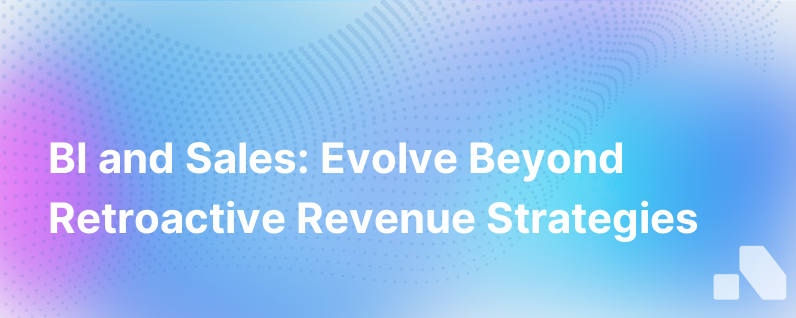
Imagine driving a car by only looking in the rearview mirror. Your perspective is limited to what's already happened, and your ability to make safe and strategic decisions for the road ahead is severely compromised. The same goes for relying exclusively on traditional business intelligence (BI) to inform sales strategies—it's like navigating the future using only the past.
In today's dynamic market landscapes, sales teams equipped with forward-looking insights can anticipate changes, identify opportunities, and shift strategies proactively. Let's explore how the paradigm is shifting from rearview BI to a predictive, data-driven approach in sales, ensuring that your revenue strategy is always looking forward, never behind.
Understanding Rearview BI
Rearview BI involves analyzing historical data to understand trends, performance, and outcomes. Sales teams review past quarters, leads conversion rates, and closed deals to gauge their success and deduce potential strategies. While this provides a useful baseline, it tells you nothing about the road ahead.
The Limitations:
- Reactive Nature: Historical data only allows reactive decision-making because it doesn’t predict future trends or market shifts.
- Time Lag: By the time you analyze past data, the market might have already changed, making your insights outdated.
- Descriptive, Not Prescriptive: Rearview BI tells you what happened, but not what to do about it.
Shifting to a Proactive Approach
The next evolution of BI in sales is a proactive stance—it's not about discarding historical data but augmenting it with real-time insights and predictive analytics. It's about using advanced AI algorithms and machine learning models to analyze current data and predict future patterns.
Key Components of a Proactive BI Approach:
1. Real-Time Analytics and Monitoring
- Dashboards: Implementing live dashboards that provide up-to-the-minute data on all metrics related to the sales process.
- Alerts: Setting up intelligent alerts that notify sales teams about significant changes or opportunities as they happen.
2. Predictive Analytics
- Forecasting Models: Utilizing statistical models to forecast future sales trends based on current and historical data.
- Opportunity Identification: Leveraging AI to identify and score leads and opportunities, predicting which are most likely to close.
3. Prescriptive Analytics
- Next Best Actions: Utilizing AI-driven recommendations on the best courses of action for sales reps to take with each prospect.
- Decision Automation: Employing systems that automatically adjust marketing and sales strategies in response to changing data patterns.
4. Machine Learning and AI Integration
- Pattern Recognition: Using machine learning to recognize complex patterns that humans may miss to identify risks and opportunities.
- Natural Language Processing (NLP): Applying NLP to interpret customer sentiments and market signals from unstructured data like emails, social media, and call transcripts.
5. Integrating Multiple Data Sources
- Data Enrichment: Combining internal sales data with external data sources such as market trends, news, competitive intelligence, and macroeconomic indicators.
- Data Unification: Ensuring that data across all platforms and departments is unified to provide a comprehensive view of the sales landscape.
Implementing a Forward-Looking BI Strategy
Transitioning to a proactive BI strategy requires carefully coordinated implementation. Here’s how to do it:
Step 1: Adopt Advanced BI Tools and Platforms
- Embrace BI solutions that support predictive and prescriptive analytics.
- Ensure that your tools can integrate with various data sources and are scalable.
Step 2: Cultivate a Data-Driven Culture
- Educate your sales team about the importance and usage of advanced analytics tools.
- Encourage data-driven decision-making at every level of the sales organization.
Step 3: Data Infrastructure and Governance
- Build a robust data infrastructure capable of handling real-time and predictive analytics.
- Implement strict data governance policies to ensure data quality and consistency.
Step 4: Continuous Learning and Adaptation
- Use AI-driven insights to continually learn and adapt your sales strategies.
- Encourage feedback loops between sales teams and data analysts to refine predictive models.
The Impact on Sales and Revenue Growth
Implementing forward-looking BI transforms how sales strategies are designed and executed:
Increased Accuracy in Forecasting: Using predictive analytics, sales teams can forecast with greater accuracy, setting more realistic targets.
Enhanced Lead Qualification: AI models help in identifying qualified leads more efficiently, thus improving conversion rates.
Strategic Allocation of Resources: Sales teams can channel efforts into the most promising accounts and territories, based on predictive insights.
Improved Customer Engagement: Real-time analytics help understand customer needs and behavior, allowing for more personalized engagement.
The Future: Beyond Traditional BI
The transition to a proactive BI approach in sales is not just a nice-to-have but a critical component of modern business strategy. The integration of cutting-edge technologies like AI and machine learning with BI tools puts actionable insights at the fingertips of decision-makers.
With the right mindset, tools, and approach, B2B sales teams can move away from driving revenue through the rearview mirror. They can instead navigate the road ahead with confidence, making smarter decisions that leverage the full power of their data to drive growth, competitive advantage, and revenue.
Conclusion
In the race to accelerate B2B sales and revenue growth in a constantly evolving landscape, the difference between victory and defeat lies in the ability to look forward. By employing a proactive BI strategy that harnesses real-time analytics, predictive modeling, and AI-driven insights, you're not just informed about the present; you're ready for the future. As technologies and tools like Aomni evolve, they empower sales teams to stay ahead of the curve, no longer constrained by the rearview mirror of traditional BI.